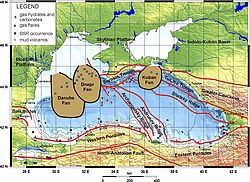Dr. Ingo Klaucke
Tel.: +49 0431 600 2335
Fax: +49 0431 600 2922
e-mail: iklaucke(at)geomar.de
Doku-Gas
Fluid flow in the Don-Kuban deep-sea fan (Black Sea) and deduced fluid venting at mud volcanoes and Cold Seeps
Project period: 01.11.2011 - 31.12.2014
Sponsored by: DFG
Applicants: Dr. Ingo Klaucke, Dr. Jörg Bialas, Prof. Dr. Christian Berndt
The Black Sea is the largest anoxic basin worldwide and offers ideal conditions for the preservation of organic matter. Decomposition of the organic matter by bacteria or thermal cracking produces large amounts of methane gas within the Black Sea sediments. The Black Sea consequently constitutes a natural laboratory for the study of gas emissions and methane cycling in the marine environment as well as possible interactions with climate changes. With ongoing discussions about gas hydrate exploitation or the use of gas hydrate reservoirs for CO2 sequestration, a good understanding of fluid and methane circulation within continental margin sediments becomes a necessity. The large number of different types of fluid-venting systems in the Black Sea (both in shallow and in deep water) makes it an ideal target for investigations with mid-size research vessels such as RV Poseidon.
Innovative geoacoustic and 3D-seismic investigations of the northern Black Sea margin in the area of the Kerch peninsula (Crimea, Black Sea) for the characterisation of near-surface and deep fluid circulation are planned. The margin south of Kerch peninsula is part of the Don-Kuban deep-sea fan and is characterised by numerous emissions of biogenic methane gas, while the peninsula itself is known for the presence of several mud volcanoes. The mud volcanoes are believed to be sourced from the 5-8 km deep Maikop formation as they expel methane of thermogenic origin. The Don-Kuban fan is under compression similar to the Sorokin Trough and unlike the Palaeo-Dnepr fan. It is expected that shallow methane emissions and mud volcanoes overlap on the upper slope and form a fluid-emission system that is different from both the Sorokin Trough and the Dnepr slope. The aim of our combined bathymetry, sidescan sonar and 3D-seismic investigations is to image the different fluidexpulsion systems and deduce the functioning of these focused fluid flow systems. The study will constrain the geometrical, physical and lithological parameters of this fluid flow system and test a number of hypotheses, e.g. that there is no difference between biogenic and thermogenic gas hydrate deposits, and that stratigraphic control is more important than structural control for the accumulation of hydrates.
Deployment of large equipment
The following large equipment are deployed during the expedition:
- ELAC Bottomchart Mk. II – 50 kHz multibeam echosounder
- DTS-1 deep towed side scan system und digital streamer
- 3D-Seismics (P-Cable)
- Ocean-bottom-seismometer
- GI-gun and superficial streamer
- Gravitiy corer with temperature sensors



